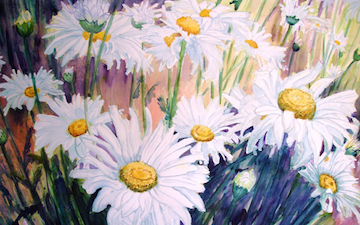The oxeye daisy (Leucanthemum vulgare, syn. Chrysanthemum leucanthemum), also known as the marguerite, is a widespread flowering plant native to Europe and the temperate regions of Asia. It is one of a number of plants to be called by the common name daisy. It is also sometimes called moon daisy or dog daisy.
It is a perennial prostrate herb with small flower head (not larger than 5 cm) that consists of about 20 white ray flowers and numerous yellow disc flowers, growing on the end of the stem. The stem is mostly unbranched and sprouts laterally from a creeping rootstock.
The leaves are dark green on both sides. The basal and middle leaves are petiolate, obovate to spoon-shaped, and serrate to dentate. The upper leaves are shorter, sessile, and borne along the stem.
It produces an abundant number of flat seeds without pappus. It spreads also vegetatively by rooting underground stems.
The oxeye daisy is often planted as a garden flower but remains a typical meadow flower, growing in a variety of plant communities such as dry fields and meadows, but also under scrubs, open-canopy forests, and waste places. It thrives in a wide range of conditions and prefers heavy and damp soils. It was introduced in parts of North America, Australia, andNew Zealand, where it is now a common weed displacing native plant species in some areas. It is difficult to control or eradicate, since a new plant can regenerate from rhizome fragments. However, in North Carolina, it is planted on roadsides by the highway department.[1]
(From Wikipedia, March 1, 2011)
– – –
This is a classic example of a daisy. There are many white daisies that have been introduced from Eurasia as ornamental and herbal plants, although the Ox-Eye Daisy has larger flowerheads (more than 1¼” across). The various cultivars of Leucanthemum x superbum (Shasta Daisy) can closely resemble Ox-Eye Daisy in general appearance. The Shasta Daisy was developed by Luther Burbank from Eurasian species. Its flowerheads tend to be larger than those of the Oxeye Daisy (more than 2″ across) and its leaves are less likely to be pinnatifid. In the Shasta Daisy, there is a brown membranous margin toward the apex of each floral bract, while the floral bracts of the Ox-Eye Daisy are brown along the entire length of their margins. Another scientific name for the Ox-Eye Daisy is Chrysanthemum leucanthemum.
(By John Hilty from illinoiswildflowers.info via EOL)
– – –




